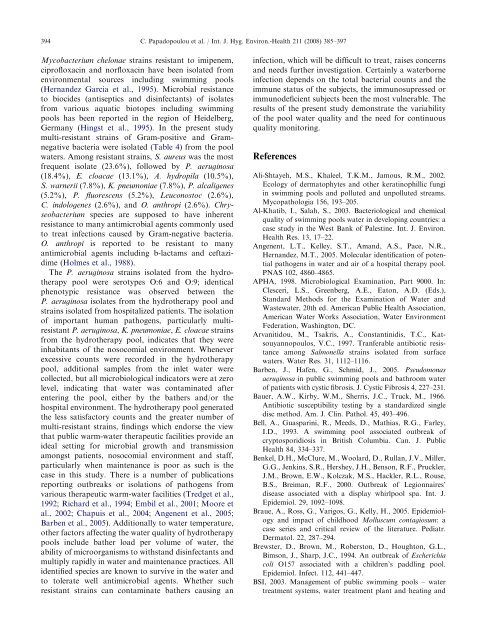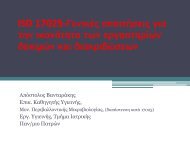Microbiological quality of indoor and outdoor swimming pools in ...
Microbiological quality of indoor and outdoor swimming pools in ...
Microbiological quality of indoor and outdoor swimming pools in ...
Create successful ePaper yourself
Turn your PDF publications into a flip-book with our unique Google optimized e-Paper software.
394<br />
Mycobacterium chelonae stra<strong>in</strong>s resistant to imipenem,<br />
cipr<strong>of</strong>loxac<strong>in</strong> <strong>and</strong> norfloxac<strong>in</strong> have been isolated from<br />
environmental sources <strong>in</strong>clud<strong>in</strong>g <strong>swimm<strong>in</strong>g</strong> <strong>pools</strong><br />
(Hern<strong>and</strong>ez Garcia et al., 1995). Microbial resistance<br />
to biocides (antiseptics <strong>and</strong> dis<strong>in</strong>fectants) <strong>of</strong> isolates<br />
from various aquatic biotopes <strong>in</strong>clud<strong>in</strong>g <strong>swimm<strong>in</strong>g</strong><br />
<strong>pools</strong> has been reported <strong>in</strong> the region <strong>of</strong> Heidelberg,<br />
Germany (H<strong>in</strong>gst et al., 1995). In the present study<br />
multi-resistant stra<strong>in</strong>s <strong>of</strong> Gram-positive <strong>and</strong> Gramnegative<br />
bacteria were isolated (Table 4) from the pool<br />
waters. Among resistant stra<strong>in</strong>s, S. aureus was the most<br />
frequent isolate (23.6%), followed by P. aerug<strong>in</strong>osa<br />
(18.4%), E. cloacae (13.1%), A. hydropila (10.5%),<br />
S. warnerii (7.8%), K. pneumoniae (7.8%), P. alcaligenes<br />
(5.2%), P. fluorescens (5.2%), Leuconostoc (2.6%),<br />
C. <strong>in</strong>dologenes (2.6%), <strong>and</strong> O. anthropi (2.6%). Chryseobacterium<br />
species are supposed to have <strong>in</strong>herent<br />
resistance to many antimicrobial agents commonly used<br />
to treat <strong>in</strong>fections caused by Gram-negative bacteria.<br />
O. anthropi is reported to be resistant to many<br />
antimicrobial agents <strong>in</strong>clud<strong>in</strong>g b-lactams <strong>and</strong> ceftazidime<br />
(Holmes et al., 1988).<br />
The P. aerug<strong>in</strong>osa stra<strong>in</strong>s isolated from the hydrotherapy<br />
pool were serotypes O:6 <strong>and</strong> O:9; identical<br />
phenotypic resistance was observed between the<br />
P. aerug<strong>in</strong>osa isolates from the hydrotherapy pool <strong>and</strong><br />
stra<strong>in</strong>s isolated from hospitalized patients. The isolation<br />
<strong>of</strong> important human pathogens, particularly multiresistant<br />
P. aerug<strong>in</strong>osa, K. pneumoniae, E. cloacae stra<strong>in</strong>s<br />
from the hydrotherapy pool, <strong>in</strong>dicates that they were<br />
<strong>in</strong>habitants <strong>of</strong> the nosocomial environment. Whenever<br />
excessive counts were recorded <strong>in</strong> the hydrotherapy<br />
pool, additional samples from the <strong>in</strong>let water were<br />
collected, but all microbiological <strong>in</strong>dicators were at zero<br />
level, <strong>in</strong>dicat<strong>in</strong>g that water was contam<strong>in</strong>ated after<br />
enter<strong>in</strong>g the pool, either by the bathers <strong>and</strong>/or the<br />
hospital environment. The hydrotherapy pool generated<br />
the less satisfactory counts <strong>and</strong> the greater number <strong>of</strong><br />
multi-resistant stra<strong>in</strong>s, f<strong>in</strong>d<strong>in</strong>gs which endorse the view<br />
that public warm-water therapeutic facilities provide an<br />
ideal sett<strong>in</strong>g for microbial growth <strong>and</strong> transmission<br />
amongst patients, nosocomial environment <strong>and</strong> staff,<br />
particularly when ma<strong>in</strong>tenance is poor as such is the<br />
case <strong>in</strong> this study. There is a number <strong>of</strong> publications<br />
report<strong>in</strong>g outbreaks or isolations <strong>of</strong> pathogens from<br />
various therapeutic warm-water facilities (Tredget et al.,<br />
1992; Richard et al., 1994; Embil et al., 2001; Moore et<br />
al., 2002; Chapuis et al., 2004; Angenent et al., 2005;<br />
Barben et al., 2005). Additionally to water temperature,<br />
other factors affect<strong>in</strong>g the water <strong>quality</strong> <strong>of</strong> hydrotherapy<br />
<strong>pools</strong> <strong>in</strong>clude bather load per volume <strong>of</strong> water, the<br />
ability <strong>of</strong> microorganisms to withst<strong>and</strong> dis<strong>in</strong>fectants <strong>and</strong><br />
multiply rapidly <strong>in</strong> water <strong>and</strong> ma<strong>in</strong>tenance practices. All<br />
identified species are known to survive <strong>in</strong> the water <strong>and</strong><br />
to tolerate well antimicrobial agents. Whether such<br />
resistant stra<strong>in</strong>s can contam<strong>in</strong>ate bathers caus<strong>in</strong>g an<br />
ARTICLE IN PRESS<br />
C. Papadopoulou et al. / Int. J. Hyg. Environ.-Health 211 (2008) 385–397<br />
<strong>in</strong>fection, which will be difficult to treat, raises concerns<br />
<strong>and</strong> needs further <strong>in</strong>vestigation. Certa<strong>in</strong>ly a waterborne<br />
<strong>in</strong>fection depends on the total bacterial counts <strong>and</strong> the<br />
immune status <strong>of</strong> the subjects, the immunosupressed or<br />
immunodeficient subjects been the most vulnerable. The<br />
results <strong>of</strong> the present study demonstrate the variability<br />
<strong>of</strong> the pool water <strong>quality</strong> <strong>and</strong> the need for cont<strong>in</strong>uous<br />
<strong>quality</strong> monitor<strong>in</strong>g.<br />
References<br />
Ali-Shtayeh, M.S., Khaleel, T.K.M., Jamous, R.M., 2002.<br />
Ecology <strong>of</strong> dermatophytes <strong>and</strong> other kerat<strong>in</strong>ophillic fungi<br />
<strong>in</strong> <strong>swimm<strong>in</strong>g</strong> <strong>pools</strong> <strong>and</strong> polluted <strong>and</strong> unpolluted streams.<br />
Mycopathologia 156, 193–205.<br />
Al-Khatib, I., Salah, S., 2003. Bacteriological <strong>and</strong> chemical<br />
<strong>quality</strong> <strong>of</strong> <strong>swimm<strong>in</strong>g</strong> <strong>pools</strong> water <strong>in</strong> develop<strong>in</strong>g countries: a<br />
case study <strong>in</strong> the West Bank <strong>of</strong> Palest<strong>in</strong>e. Int. J. Environ.<br />
Health Res. 13, 17–22.<br />
Angenent, L.T., Kelley, S.T., Am<strong>and</strong>, A.S., Pace, N.R.,<br />
Hern<strong>and</strong>ez, M.T., 2005. Molecular identification <strong>of</strong> potential<br />
pathogens <strong>in</strong> water <strong>and</strong> air <strong>of</strong> a hospital therapy pool.<br />
PNAS 102, 4860–4865.<br />
APHA, 1998. <strong>Microbiological</strong> Exam<strong>in</strong>ation, Part 9000. In:<br />
Clesceri, L.S., Greenberg, A.E., Eaton, A.D. (Eds.),<br />
St<strong>and</strong>ard Methods for the Exam<strong>in</strong>ation <strong>of</strong> Water <strong>and</strong><br />
Wastewater, 20th ed. American Public Health Association,<br />
American Water Works Association, Water Environment<br />
Federation, Wash<strong>in</strong>gton, DC.<br />
Arvanitidou, M., Tsakris, A., Constant<strong>in</strong>idis, T.C., Katsouyannopoulos,<br />
V.C., 1997. Tranferable antibiotic resistance<br />
among Salmonella stra<strong>in</strong>s isolated from surface<br />
waters. Water Res. 31, 1112–1116.<br />
Barben, J., Hafen, G., Schmid, J., 2005. Pseudomonas<br />
aerug<strong>in</strong>osa <strong>in</strong> public <strong>swimm<strong>in</strong>g</strong> <strong>pools</strong> <strong>and</strong> bathroom water<br />
<strong>of</strong> patients with cystic fibrosis. J. Cystic Fibrosis 4, 227–231.<br />
Bauer, A.W., Kirby, W.M., Sherris, J.C., Truck, M., 1966.<br />
Antibiotic susceptibility test<strong>in</strong>g by a st<strong>and</strong>ardized s<strong>in</strong>gle<br />
disc method. Am. J. Cl<strong>in</strong>. Pathol. 45, 493–496.<br />
Bell, A., Guaspar<strong>in</strong>i, R., Meeds, D., Mathias, R.G., Farley,<br />
I.D., 1993. A <strong>swimm<strong>in</strong>g</strong> pool associated outbreak <strong>of</strong><br />
cryptosporidiosis <strong>in</strong> British Columbia. Can. J. Public<br />
Health 84, 334–337.<br />
Benkel, D.H., McClure, M., Woolard, D., Rullan, J.V., Miller,<br />
G.G., Jenk<strong>in</strong>s, S.R., Hershey, J.H., Benson, R.F., Pruckler,<br />
J.M., Brown, E.W., Kolczak, M.S., Hackler, R.L., Rouse,<br />
B.S., Breiman, R.F., 2000. Outbreak <strong>of</strong> Legionnaires’<br />
disease associated with a display whirlpool spa. Int. J.<br />
Epidemiol. 29, 1092–1098.<br />
Braue, A., Ross, G., Varigos, G., Kelly, H., 2005. Epidemiology<br />
<strong>and</strong> impact <strong>of</strong> childhood Molluscum contagiosum: a<br />
case series <strong>and</strong> critical review <strong>of</strong> the literature. Pediatr.<br />
Dermatol. 22, 287–294.<br />
Brewster, D., Brown, M., Roberston, D., Houghton, G.L.,<br />
Bimson, J., Sharp, J.C., 1994. An outbreak <strong>of</strong> Escherichia<br />
coli O157 associated with a children’s paddl<strong>in</strong>g pool.<br />
Epidemiol. Infect. 112, 441–447.<br />
BSI, 2003. Management <strong>of</strong> public <strong>swimm<strong>in</strong>g</strong> <strong>pools</strong> – water<br />
treatment systems, water treatment plant <strong>and</strong> heat<strong>in</strong>g <strong>and</strong>



